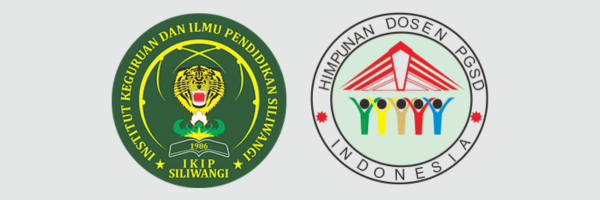Reading Mapping and Sharing (RMS) Model: Improving Critical Thinking Skills of Elementary School Students on Cultural Diversity Material
DOI:
https://doi.org/10.22460/pej.v9i2.6154Kata Kunci:
21St-Century Skills , Reading , Mapping, Sharing, Critical Thinking SkillsAbstrak
The main problem in this study is the low critical thinking skills of students and the learning strategies applied by teachers are still ineffective in learning. The purpose to be achieved in this study is to analyse the Reading, Mapping and Sharing learning model on the critical thinking skills of students in elementary schools. The focus of this research is: Effective learning syntax using the Reading, Mapping and Sharing learning model, and the effect of the Reading, Mapping and Sharing Model on students' critical thinking skills in elementary schools. The method used in this research is experimental method with one group pre test post test. This research was conducted in one of elementary school in Jakarta, with the object of research being class 4 as many as 28 students. Data collection instruments included the syntax of the application of the Reading Mapping and Sharing model, observation sheets of students' critical thinking skills. Data were analysed quantitatively. The results of this study are the stages of learning activities of the Reading Mapping Sharing model in the learning process and the results of students' critical thinking skills in elementary schools.
Referensi
Abrami, P. C., Bernard, R. M., Borokhovski, E., Waddington, D. I., Wade, C. A., & Persson, T. (2015). Strategies for Teaching Students to Think Critically: A Meta-Analysis. Review of Educational Research, 85(2), 275–314. https://doi.org/10.3102/0034654314551063
Ardiansyah, A., & Akbar, M. N. (2024). The Efficacy of the Reading, Mind Mapping, and Sharing Learning Model in Boosting Students’ Problem-Solving Skills. Indonesian Journal of Islamic Education Studies (IJIES), 7(2), 163–178. https://doi.org/10.33367/ijies.v7i2.5929
Arigawati, N. H., & Kusnandi, K. (2021). Students Critical Thinking Reviewed from Field-Dependent and Field-Independent on Number Pattern Material. JTAM (Jurnal Teori Dan Aplikasi Matematika), 5(1), 236. https://doi.org/10.31764/jtam.v5i1.3923
Aulia, V., & Yamin, M. (n.d.). Students’ Activities in Integrated Thematic Textbooks for Primary School to Meet 21st Century Skills.
Azim, O., & Nargiza, M. (2024). Research Of The Topic Of Thinking In Psychology. International Journal of Advance Scientific Research, 05(12), 101–106. https://doi.org/10.37547/ijasr-04-12-17
Bailin, S., Case, R., Coombs, J. R., & Daniels, L. B. (1999). Common misconceptions of critical thinking. Journal of Curriculum Studies, 31(3), 269–283. https://doi.org/10.1080/002202799183124
Dwiastuti, S., Widoretno, S., Ramli, M., Saputra, A., & Prabowo, C. A. (2021). Implementation of Blended Learning to Improve Critical Thinking Skills and Motivation. Bioedukasi: Jurnal Pendidikan Biologi, 14(1), 17. https://doi.org/10.20961/bioedukasi-uns.v14i1.44223
Dwyer, C. P., Hogan, M. J., & Stewart, I. (2014). An integrated critical thinking framework for the 21st century. Thinking Skills and Creativity, 12, 43–52. https://doi.org/10.1016/j.tsc.2013.12.004
Facione, P. (2013). Critical Thinking: What It Is and Why It Counts. Pearson Education.
Fajari, L. E. W. (2021). Critical Thinking Skills and Their Impacts on Elementary School Students. Malaysian Journal of Learning and Instruction, 18. https://doi.org/10.32890/mjli2021.18.2.6
Fisher, A. (2008). Critical thinking: An introduction. Erlangga. https://lib.ui.ac.id/detail.jsp?id=20401661
Halpern, D. F., & Dunn, D. S. (2021). Critical Thinking: A Model of Intelligence for Solving Real-World Problems. Journal of Intelligence, 9(2), 22. https://doi.org/10.3390/jintelligence9020022
Hidayah, R., Salimi, Moh., & Susiani, T. S. (2017). Critical Thinking Skills: Konsep dan Indikator Penilaian. Taman Cendekia: Jurnal Pendidikan Ke-SD-an, 1(2), 127–133. https://doi.org/10.30738/tc.v1i2.1945
Hudson, M. E., & Test, D. W. (2011). Evaluating the Evidence Base of Shared Story Reading to Promote Literacy for Students with Extensive Support Needs. Research and Practice for Persons with Severe Disabilities, 36(1–2), 34–45. https://doi.org/10.2511/rpsd.36.1-2.34
Indrašienė, V., Jegelevičienė, V., Merfeldaitė, O., Penkauskienė, D., Pivorienė, J., Railienė, A., & Sadauskas, J. (2023). Critical Reflection in Students’ Critical Thinking Teaching and Learning Experiences. Sustainability, 15(18), 13500. https://doi.org/10.3390/su151813500
Li, T. (2023). A Study of the Relationship Between Individuals and the Society. Lecture Notes in Education Psychology and Public Media, 9(1), 224–229. https://doi.org/10.54254/2753-7048/9/20230182
Malabanan, J. C., Briones, E., & Madrideo, J. (2022). Pre-service Teachers’ Readiness on Online Learning and their 21st Century Pedagogical Skills. International Journal of Educational Management and Development Studies, 3(3), 65–83. https://doi.org/10.53378/352909
Mulnix, J. W. (2012). Thinking Critically about Critical Thinking. Educational Philosophy and Theory, 44(5), 464–479. https://doi.org/10.1111/j.1469-5812.2010.00673.x
Mulyani, A. Y. (2022). Pengembangan Critical Thinking Dalam Peningkatan Mutu Pendidikan di Indonesia. DIAJAR: Jurnal Pendidikan dan Pembelajaran, 1(1), 100–105. https://doi.org/10.54259/diajar.v1i1.226
Nisa, F. A., Dwiningsih, K., & Myranthika, F. O. (2023). Improving Students’ Learning Outcomes and Activities through the Implementation of the Discovery Learning Model on Mol Concept Material. Prisma Sains : Jurnal Pengkajian Ilmu Dan Pembelajaran Matematika Dan IPA IKIP Mataram, 11(3), 816. https://doi.org/10.33394/j-ps.v11i3.8525
Novitasari, M., Narimo, S., Fajri, D. N., & Raisia, A. (2022). Critical Thinking Skills Through Literacy and Numeration Oriented Mathematics Student Worksheet. Jurnal Basicedu, 6(4), 5775–5784. https://doi.org/10.31004/basicedu.v6i4.3173
O’Reilly, C., Devitt, A., & Hayes, N. (2022). Critical thinking in the preschool classroom—A systematic literature review. Thinking Skills and Creativity, 46, 101110. https://doi.org/10.1016/j.tsc.2022.101110
Orhan, A. (2022). The Relationship between Critical Thinking and Academic Achievement: A Meta-Analysis Study. Psycho-Educational Research Reviews, 11(1). https://doi.org/10.52963/PERR_Biruni_V11.N1.18
Paul, R., & Elder, L. (2019). The Miniature Guide to Critical Thinking Concepts and Tools. Bloomsbury Publishing. https://books.google.co.id/books?id=Cm6pDwAAQBAJ
Perez, A., Green, J., Moharrami, M., Gianoni-Capenakas, S., Kebbe, M., Ganatra, S., Ball, G., & Sharmin, N. (2023). Active learning in undergraduate classroom dental education- a scoping review. PLOS ONE, 18(10), e0293206. https://doi.org/10.1371/journal.pone.0293206
Rachid, B., & Sakale, D. S. (n.d.). Enhancing Critical Thinking Skills and Communication Skills through Flipped Learning Technology in Moroccan Middle Schools.
Rahmawan, A. D., & Perianto, E. (2021). Identifying Students’ Problems on Critical Thinking as a Way to Foster Higher Order Thinking Skills. PIONEER: Journal of Language and Literature, 13(2), 260. https://doi.org/10.36841/pioneer.v13i2.1288
Segara, N. B., Maryani, E., Supriatna, N., & Ruhimat, M. (2018). Investigated The Implementation of Map Literacy Learning Model. Geosfera Indonesia, 3(2), 146. https://doi.org/10.19184/geosi.v3i2.7808
Sugiyono. (2022). Metode Penelitian Kuatitatif, Kualitatif dan R & D. ALFABETA.
Thornhill-Miller, B., Camarda, A., Mercier, M., Burkhardt, J.-M., Morisseau, T., Bourgeois-Bougrine, S., Vinchon, F., El Hayek, S., Augereau-Landais, M., Mourey, F., Feybesse, C., Sundquist, D., & Lubart, T. (2023). Creativity, Critical Thinking, Communication, and Collaboration: Assessment, Certification, and Promotion of 21st Century Skills for the Future of Work and Education. Journal of Intelligence, 11(3), 54. https://doi.org/10.3390/jintelligence11030054
Toews, S. G., McQueston, J., & Kurth, J. A. (2021). Evaluation of the Evidence Base for Shared Reading to Support Literacy Skill Development for Students with Extensive Support Needs. Research and Practice for Persons with Severe Disabilities, 46(2), 77–93. https://doi.org/10.1177/15407969211008531
Wan Elnayla Azzahra Reza, Zahara Tul Husni, Elsya Frilia Ananda N, Bias Tirta Bayu, & Wismanto Wismanto. (2024). Ayat-Ayat Pendidikan Tentang Potensi Manusia Dalam Pengetahuan (Knowladge), Ilmu Pengetahuan (Sains), Filsafat, Dan Agama. Al-Tarbiyah : Jurnal Ilmu Pendidikan Islam, 2(3), 59–72. https://doi.org/10.59059/al-tarbiyah.v2i3.1153
Worachak, S. P., Damnoen, P. S., & Hong, D. A. C. (2023). Analysis Of Critical Thinking Skills In Problem-Based Learning And Inquiry Learning Models. EduFisika: Jurnal Pendidikan Fisika, 8(3), 282–293. https://doi.org/10.59052/edufisika.v8i3.29442
Yanuarto, W. N., & Hapsari, I. (2022). The Model of Creative Thinking, Critical Thinking, and Entrepreneurial Skills Among University Students. JTAM (Jurnal Teori Dan Aplikasi Matematika), 6(2), 411. https://doi.org/10.31764/jtam.v6i2.7467
Unduhan
Diterbitkan
Terbitan
Bagian
Lisensi

Artikel ini berlisensiCreative Commons Attribution-ShareAlike 4.0 International License.
The author is responsible for acquiring the permission(s) to reproduce any copyrighted figures, tables, data, or text that are being used in the submitted paper. Authors should note that text quotations of more than 250 words from a published or copyrighted work will require grant of permission from the original publisher to reprint. The written permission letter(s) must be submitted together with the manuscript.











